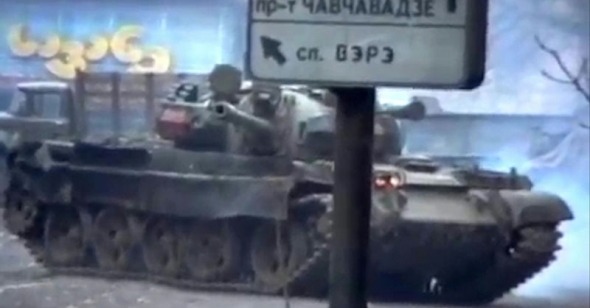Final Assembly
By Julia Gunnison
Limitation
Dir. Elene Asatiani and Soso Dumbadze, Georgia, no distributor
Limitation screened Sunday, March 17, at Museum of the Moving Image as part of First Look 2024.
In Limitation (2023), Elene Asatiani and Soso Dumbadze assemble an account of the Tblisi War from primary source footage uploaded to the internet. The conflict took place in Georgia’s capital from December 22, 1991, to January 6, 1992, ending when opposition forces, led by National Guard commander Tengiz Kitovani, ousted President Zviad Gamsakhurdia, the country’s popular leader who had been elected just eight months prior in newly independent Georgia’s first democratic elections. Progressing in roughly chronological order, the movie begins as Georgia establishes statehood in April 1991, wresting itself from the collapsing Soviet Union. From there, a series of political contortions propel the country into chaos. Delineating a war requires accounting for tremendous complexity and historical context that’s difficult to capture in 120 minutes. But as this film conveys, the best storytellers are the city streets.
At the beginning of the movie, crowds spill across Rustaveli Avenue, Tbilisi’s main thoroughfare, in celebration. Soon, however, the joyful character of the public gathering takes a turn. Gamsakhurdia’s opponents speak out against him; the street becomes the site of debate, and then aggression. Citizens tussle with each other; soldiers attack the crowd; tanks appear as throngs of people circle in dismay, alarm, support, dissent, and confusion. Just as the street appears to reach maximum capacity, it empties—the transformation from public forum to war zone is complete. The only people remaining are small groups of soldiers and rebels, and the occasional civilian scurrying by, trying their luck against flying bullets. Once the street becomes a fighting ground, crowds only gather inside. Unlike open, public space, these interiors are strictly demarcated places belonging to either government, or opposition. By the end of the film, Rustaveli Avenue is burned, shelled, and littered with rubble. A man who’s just returned to Tblisi walks around in a daze. Gone for only a month, he cannot find his way home.
The physical conditions in the streets provide a clear depiction of how war takes over Tblisi, serving as the most straightforward visual marker of the conflict’s development in a film that refrains from contextualizing its material with explanatory text or voiceover; none of the audio from the archival footage is altered. Without narrative guardrails, viewers unfamiliar with the war and its actors may have difficulty comprehending the political maneuverings the film attempts to unpack. But there is utility to this indiscernibility. By letting the archive speak for itself, the film asks the viewer to actively interpret, rather than passively receive, what is on screen. The necessity of interpretation is integral to Limitation, as the archival material that comprises the film is by nature tendentious.
Asatiani and Dumbadze label every shot with a title in the upper-right-hand corner that states what party shot the footage. Examples include “Undefined Camera,” “International Media,” “Private Camera,” “KGB Camera,” and “Election Clip”. The majority of the footage is given one of two labels: “Pro-Government Camera” or “Pro-Opposition Camera.” These call attention to the biases inherent to the images. Their phrasing is instructive: the camera itself, not the cameraperson, is identified as being for one side or another, suggesting the political potency of the camera as a propagandist tool, a power possibly beyond the control of even its operator. A good politician, Gamsakhurdia understood that how and what one chooses to shoot is naturally prejudiced. In one scene, he denies CNN’s Christiane Amanpour access to himself or his headquarters beyond a staged interview environment. Another instance features pro-government soldiers offering patriotic lines to the camera, one by one. “Mention Gamsakhurdia,” urges a voice behind the camera. In an early scene, the film excerpts a statement Gamsakhurdia gave as a younger man disavowing his dissident activity; as the action unfolds, it becomes evident his speech is a forced recantation scripted by the KGB. These moments render visible the construction of speech and images that become historical record.
In one key scene, two young men tell a pro-government camera how they were forcibly recruited by the opposition. Someone asks them how the opposition acquired their weapons. As they explain seeing Soviet troops supplying guns, a voice interrupts them: “Did you see, or were you told?” This question, of how we know what we know, what constitutes truth, and what we accept as evidence, lies at the heart of the movie. Limitation compares the vocabulary employed by those on both sides of the conflict. Democracy, equal rights, liberation—such words are used by leaders of all political persuasions. But when the opposition defines democracy as a system wherein “all provocateurs will be shot on the spot,” the word loses its meaning.
Amid the ongoing conflict, a group of administrators enters a government building they had abandoned. They find that a number of historic tapes are missing, though a portion they brought with them when evacuating the offices are safe. It’s a moment that speaks, like the entire film itself, to the fragility of archives. What is preserved versus what is lost can be as capricious as a split-second decision by an office worker made under extreme conditions. The staff looks around at what’s left that should be carried away from danger: a satellite device, a Soviet encyclopedia, pins, glue. The trove of footage discovered by Asatiani and Dumbadze on the internet that they transform into a movie—can we assume it will always be there? As the war in Ukraine continues to destabilize the region, it’s natural that an impulse to collect images surges, as such times of war make archives most urgent and most vulnerable. Collecting this footage, and all its complications, in a contained, narrative format is a means of activating this history, and challenging our conception of how the past is recorded, preserved, and learned.
